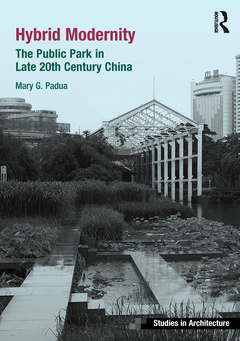Hybrid Modernity The Public Park in Late 20th Century China Ashgate Studies in Architecture Series

This book provides a detailed historical and design analysis of the development of parks and modern landscape architecture in late 20th century China. It questions whether the fusion of international influences with the local Chinese design vocabulary in late 20th century China has created a distinctive and novel approach to the design of public parks.
Hybrid Modernity proposes a new theory for examining the design of public parks built in post-Mao China since the reforms and sets the various processes for China?s late 20th century socio-cultural context. Drawing on modernization theory, research on China?s modernity, local and global cultural trends, it illustrates through a range of case studies ways hybrid modernity defines a new design genre and language for the spatial forms of parks that emerged in China?s secondary cities. Featured case studies include the Living Water Park in Chengdu, Sichuan province, Zhongshan Shipyard Park in Guangdong Province, Jinji Lake Landscape Master Plan in Suzhou, Jiangsu province, and the West Lake Southern Scenic Area Master Plan in Hangzhou, Zhejiang province. This book argues that these forms represent a new stage in China?s history of landscape architecture. The work reveals that as a new profession, landscape architecture has greatly contributed to China?s massive urban experiment.
This book is an ideal read for students enrolled in landscape architecture, architecture, fine arts and urban planning programs who are engaged in learning the arts and international design education.
Table of Contents
Preface
List of Figures and Tables
1 Introducing Hybrid Modernity
Post-Mao transformations: framing hybrid modernity
China’s physical setting and settlement patterns
Book scope and structure
2 Navigating Modern(s) and the Park in modern China Modernization: social construction and nation-building
Modernity, Globalization and Identity
Hybrid modernization: expanding modernization theory and alternative modernities
Re-visiting Modernism (international) genre
Modernism in Architecture and Landscape Architecture
Modernity in China
China’s early modernity and westernization
Forced (Colonial) Modernity
The Public Park, Republican modernity (1912-1949) and nation-building
Mao’s Modernity: 1949 – 1976
Summarizing China’s modern experience
3 Pre-Modern China: Nature, Cosmology, Mythology and the Chinese Picturesque
Nature, Cosmology, Mythology and Folklore
Brief History of China’s designed landscapes
Interpreting garden-making throughout pre-modern China
Chinese Picturesque Garden Design Language
4 Looking “Inside” and “Outside” post-Mao China
A Glance back at the Arts and Culture in the Mao era
Inside Post-Mao China
Post-Mao art trends
Trends in post-Mao China’s Built Environment
Post-Mao Landscape Architecture: foundations of professional practice and education
Landscape Architecture “Outside” post-Mao China
5 Revealing late 20th century Hybrid Modernity: four purpose-built parks
Case Study One: Living Water Park, Huoshui Gongyuan, Chengdu, Sichuan
Chengdu context
Project inception
Design Realization
Hybrid Modern synthesis
Case Study Two: Zhongshan Shipyard Park, Zhongshan Shiqi Jiang Gongyuan, Zhongshan, Guangdong
Zhongshan context
Project Inception
Design realization
Hybrid Modern synthesis
Case Study Three: Jinji Lake Landscape Master Plan, Jinji Hu Jingguan Zongti Guihua Suzhou, Jiangsu
Suzhou context
Project Inception
Project realization
Hybrid Modern synthesis
Case Study Four: West Lake Southern Scenic Area Master Plan, Xihu Huanhu Nanxian Jingqu Zongti, Hangzhou, Zhejiang
West Lake, Hangzhou context
Project Inception
Project Realization
SSA Experience
Hybrid Modern synthesis
Four public parks – the schema for post-Mao China’s hybrid modernity
6 Transforming from ‘Hybrid’ to ‘Ecological’ Modernization in China’s 21st century
Four case study parks and trends in the host cities
Top-Down China + Five-Year-Plan = Green Revolution and Ecological Modernization
China’s Sponge City program and contribution to international “green” urbanism
Revolutionary Praxis, Trends and Beautiful China
Index
Mary G. Padua, PhD, RLA, is an internationally recognized educator, thought leader, contemporary theorist and artist. Her research focuses on socio-cultural phenomena, human-centered design and the meaning of public space. She is one of the first English language writers on post-Mao designed landscapes and the discipline of landscape architecture as contributing agents to China’s late 20th century urban experiment. She maintains MGP Studio, a critically minded practice rooted in craft, equity, inclusion and restorative experiences, and teaches at Clemson University’s School of Architecture.
Date de parution : 01-2023
17.4x24.6 cm
Date de parution : 07-2020
17.4x24.6 cm
Thèmes de Hybrid Modernity :
Mots-clés :
West Lake; Hybrid Modernization; landscape architecture; modern landscape architecture; Water Park; international design education; Sip; hybrid modernity; Central Government; public parks; Public Infrastructure; Yangtze River; Secondary Cities; National Scenic Areas; Forbidden City; SWA; Harmonious Society; Scholar Gardens; Sponge City; Landscape Architecture Praxis; Qing Imperial Court; Beautiful China; Treaty Port Cities; Roc; Landscape Architecture Education; Chinese Garden; Ecological Modernization; Hangzhou’s Municipal Government



